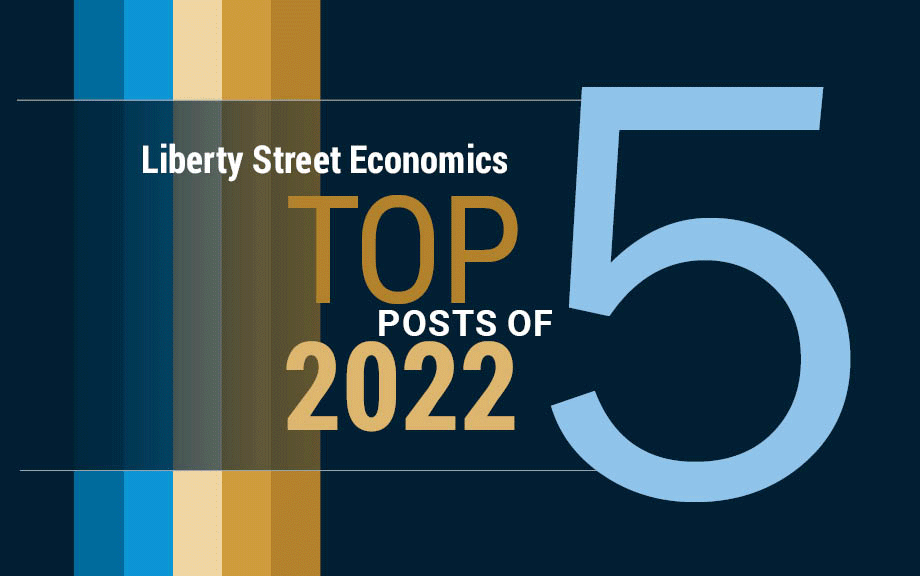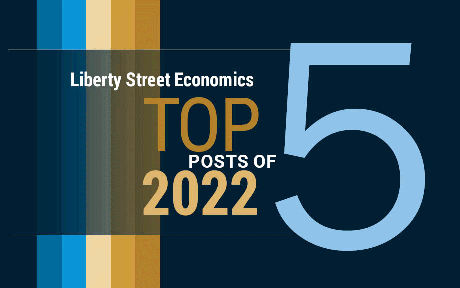

“Kitchen table” issues were on the minds of our readers in 2022, though what was labeled as such was perhaps a bit broader than in the past. Supply chains—now firmly placed on the radar of Main Street—were the subject of the year’s top post by number of page views and accounted for three of the top five (we’ll consider them as one for this roundup). Student debt forgiveness and inflation were also in the news, drawing readers to our preview of various possibilities for the (subsequently announced) federal student loan forgiveness program and a quarterly update of a New York Fed economic forecast model. Posts on more technical topics were popular as well, including an update on the Federal Reserve’s balance sheet “runoff” and a discussion of stablecoins. Underscoring their broad appeal, the year’s top two posts rank among the top five in the history of Liberty Street, which dates back to 2011. Read on to see which posts resonated most with readers.

By Gianluca Benigno, Julian di Giovanni, Jan J. J. Groen, and Adam I. Noble
Supply chain issues were everywhere this year, as disruptions that began during the early days of the pandemic continued to affect both the cost and availability of goods. The year’s top post introduced a new gauge offering a comprehensive summary of potential disruptions affecting global supply chains—the Global Supply Chain Pressure Index, or GSCPI. The authors describe the indicators included in the index and show the trends in its components and in the GSCPI itself back to 1997. The index generated such strong interest that the post became the second-highest-ranked in the history of the blog, and two subsequent posts—one offering an update of the index, another announcing its launch as a regular release of the New York Fed—also cracked the top five for the year. (January 4)
See also:
Global Supply Chain Pressure Index: March 2022 Update (March 3)
Global Supply Chain Pressure Index: May 2022 Update (May 18)

By Jacob Goss, Daniel Mangrum, and Joelle Scally
Several months before the White House announced its program to forgive federal student debt, our researchers conducted an analysis of the costs and benefits of a number of hypothetical proposals. Their post, part of our Economic Inequality Series, used representative data from anonymized credit reports to identify federal loans, calculate the total cost of each proposal, explore key differences in who owes federal student loans, and examine who would likely benefit from federal student loan forgiveness under the various scenarios. Strong media coverage of the post drove readership and helped propel it into Liberty Street’s top five of all time. (April 21)
The authors revisited these issues in September after the White House announced its plan for student debt forgiveness (currently on hold), using the same anonymized credit report data to update their framework. The follow-up post offered estimates for the total amount of forgiven loans and the distribution of who holds federal student loans before and after implementation.

By Marco Del Negro, Aidan Gleich, Shlok Goyal, Alissa Johnson, and Andrea Tambalotti
The authors presented the June update of the economic forecasts generated by the New York Fed’s dynamic stochastic general equilibrium (DSGE) model (which is not an official New York Fed forecast, but an input to the Research staff’s overall forecasting process), offering an outlook that was considerably more pessimistic than the previous update in March. Publication of the post came amid heightened interest in, and concerns about, the economy—just days after headline-making developments such as CPI inflation hitting a (then) forty-year high, national average gasoline prices hitting a (still) all-time high of $5 a gallon, the Federal Reserve announcing the largest increase in interest rates since 1994, and steep declines in stock markets. The post’s authors, as always, offered forecasts of GDP output growth, inflation, and the real natural rate of interest, but its readership was anything but routine, generating more than six times the quarterly update’s usual page views. (June 17)
To see more recent forecasts for these variables, view the September and December DSGE updates. You can also view our archive of DSGE updates, dating back to 2015.

By Marco Cipriani, James Clouse, Lorie Logan, Antoine Martin, and Will Riordan
The authors updated a 2017 Liberty Street Economics post that described the balance sheet effects of the Federal Open Market Committee’s decision to reduce reinvestments of the proceeds of maturing securities, commencing the Federal Reserve’s balance sheet “runoff.” In 2017, the overnight reverse repo (ON RRP) facility was fairly small and therefore it wasn’t mentioned in the earlier post for the sake of simplicity. But at the time of this update, take-up at the ON RRP facility was more than $1.5 trillion (and subsequently hit a peak of more than $2.4 trillion in September, before falling back a bit). In this post, the authors describe how the presence of the ON RRP facility affects the mechanics of balance sheet runoff when newly issued securities (such as Treasury securities) are purchased by banks and money market funds. (April 11)
A companion post discussed what happens when the newly issued securities are purchased by levered nonbank financial institutions (NBFIs), such as hedge funds or nonbank dealers, and by households.

By Rod Garratt, Michael Lee, Antoine Martin, and Joseph Torregrossa
Stablecoins—digital assets used as a medium of exchange that are purported to be backed by assets held specifically for that purpose—grew considerably in 2020 and 2021, rising from a market capitalization of $5.7 billion on December 1, 2019, to $155.6 billion on January 21, 2022. As a result, analysts began paying increased attention to the stablecoin market, and the President’s Working Group on Financial Markets released a stablecoins report in November 2021. In this post from February, which predated the market gyrations caused by the collapse of TerraUSD in May and the failure of FTX in November, the authors explained why they believe stablecoins are unlikely to be the future of payments. (February 7)
How to cite this post:
, “Supply Chains, Student Debt, and Stablecoins—The Top 5 Liberty Street Economics Posts of 2022,” Federal Reserve Bank of New York Liberty Street Economics, December 22, 2022, https://libertystreeteconomics.newyorkfed.org/2022/12/supply-chains-student-debt-and-stablecoins-the-top-5-liberty-street-economics-posts-of-2022/.
Disclaimer
The views expressed in this post are those of the author(s) and do not necessarily reflect the position of the Federal Reserve Bank of New York or the Federal Reserve System. Any errors or omissions are the responsibility of the author(s).
Source link
